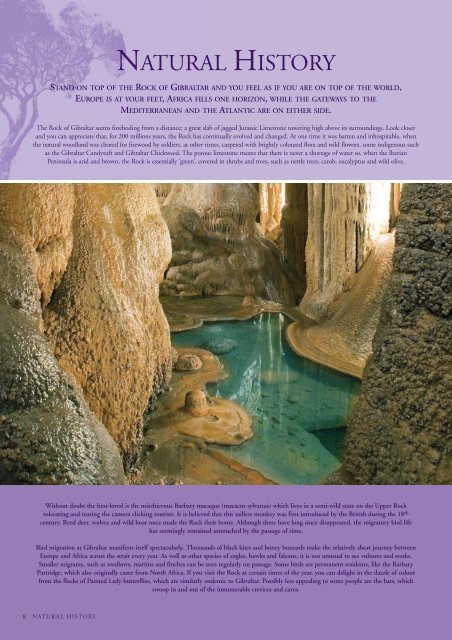GIBRALTAR
GIB_Main Brochure 2008:GIB_15_Main Brochure 2007 - Pogoria.org
GIB_Main Brochure 2008:GIB_15_Main Brochure 2007 - Pogoria.org
- No tags were found...
You also want an ePaper? Increase the reach of your titles
YUMPU automatically turns print PDFs into web optimized ePapers that Google loves.
NATURAL HISTORY<br />
STAND ON TOP OF THE ROCK OF <strong>GIBRALTAR</strong> AND YOU FEEL AS IF YOU ARE ON TOP OF THE WORLD,<br />
EUROPE IS AT YOUR FEET, AFRICA FILLS ONE HORIZON, WHILE THE GATEWAYS TO THE<br />
MEDITERRANEAN AND THE ATLANTIC ARE ON EITHER SIDE.<br />
The Rock of Gibraltar seems foreboding from a distance; a great slab of jagged Jurassic Limestone towering high above its surroundings. Look closer<br />
and you can appreciate that, for 200 millions years, the Rock has continually evolved and changed. At one time it was barren and inhospitable, when<br />
the natural woodland was cleared for firewood by soldiers, at other times, carpeted with brightly coloured flora and wild flowers, some indigenous such<br />
as the Gibraltar Candytuft and Gibraltar Chickweed. The porous limestone means that there is never a shortage of water so, when the Iberian<br />
Peninsula is arid and brown, the Rock is essentially ‘green’, covered in shrubs and trees, such as nettle trees, carob, eucalyptus and wild olive.<br />
Without doubt the best-loved is the mischievous Barbary macaque (macacus sylvanus) which lives in a semi-wild state on the Upper Rock<br />
tolerating and teasing the camera clicking tourists. It is believed that this tailless monkey was first introduced by the British during the 18 th<br />
century. Reed deer, wolves and wild boar once made the Rock their home. Although these have long since disappeared, the migratory bird life<br />
has seemingly remained untouched by the passage of time.<br />
Bird migration at Gibraltar manifests itself spectacularly. Thousands of black kites and honey buzzards make the relatively short journey between<br />
Europe and Africa across the strait every year. As well as other species of eagles, hawks and falcons, it is not unusual to see vultures and storks.<br />
Smaller migrants, such as swallows, martins and finches can be seen regularly on passage. Some birds are permanent residents, like the Barbary<br />
Partridge, which also originally came from North Africa. If you visit the Rock at certain times of the year, you can delight in the dazzle of colour<br />
from the flocks of Painted Lady butterflies, which are similarly endemic to Gibraltar. Possibly less appealing to some people are the bats, which<br />
swoop in and out of the innumerable crevices and caves.<br />
8<br />
NATURAL HISTORY












